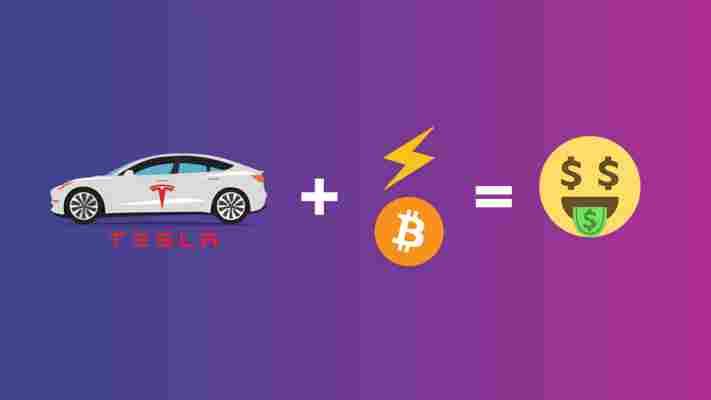A clever Tesla owner is using his Model S to mine cryptocurrency for free
Building a cryptocurrency miner that doubles as a heater is cool, but one inventor has taken the concept of mining to a whole new level. A creative Tesla owner managed to fit a legitimate mining rig inside the trunk of his shiny Model S.

But here is the best part: all the electricity needed to keep the mining rig running is coming from Tesla’s free Superchargers – or so the inventor says. The quirky setup went viral after the inventor took to Facebook group Tesla Owners Worldwide to share images of the Model S-fitted miner.
Credit: Facebook / Tesla Owners Woldwide
For those unfamiliar with the term, mining refers to the process of solving series of cryptographic puzzles in order to verify transactions on the blockchain. One of the common issues with mining, though, is that it requires a substantial amount of computing power – which in turn results in bigger electricity bills.
For this reason, miners are constantly seeking for more environment-friendly and cost-efficient solutions . In fact, this is precisely how the idea for the Tesla-miner came to exist.
Another member of Tesla Owners Worldwide jokingly suggested fitting a miner inside a Model S could help avoiding huge energy bills by relying on electricity from the free Supercharger network. Well, someone thought this is indeed a good idea.
Judging by the images, the mining rig in question uses GPUs to solve puzzles. This means that, while it isn’t suitable for mining Bitcoin (which requires ASIC chips), it could mine other cryptocurrencies like Ethereum .
Still, as Motherboard points out, putting a crypto-miner inside your Tesla might not be the smartest idea. According to their calculations, the monthly income you can generate by running the miner from your trunk just about equals the average monthly lease for a Model S (assuming the owner is on one of Tesla’s free Supercharger programs).
Yes, the miner will eventually pay for the Tesla, but you’ll have to keep it running 24/7 for years to get to that point. That is, assuming Tesla keeps its Superchargers free, which might not be the case . Not to mention that – factoring in the heat generated by the GPUs inside – you’ll practically be turning your vehicle into an oven.
Coinbase is giving USers immediate deposits and higher cryptocurrency trading limits
Good news for crypto-traders: Coinbase will be enabling instant cryptocurrency purchases and higher daily limits for trading and deposits.

A new update is going to be rolled out that will make it possible to purchase $25,000 worth of cryptocurrency every day for US users. Once live, deposits should be immediate, with the daily trade limit also being increased to match the new purchase limit.
The release reads:
The fine print
Only verified users will be able to make use of the new features. It remains unclear when the features will go live – though Coinbase expects it to be rolled out over the coming month.
Debit cards won’t have the same limit – it’s lower, up to $7,500 a week. If users want to deposit more, they will need to deposit funds via bank transfer.
The release also states that the upgrade will be available to a “majority” of the US – this is in reference to the aforementioned verification requirements, as confirmed by Coinbase to Hard Fork via e-mail.
Deposits above these limits have really always been possible one way or another – the biggest takeaway here is that funds sent via direct debit will be much quicker and available for trade instantly.
UK Coinbase to get even higher limits
While US investors are surely happy to enjoy more freedoms when buying cryptocurrency, those in the UK are being catered as well. Coinbase is now hooked up to Faster Payments, which means that it finally allows deposits in Pound Sterling.
The limit for transactions through Faster Payments is a whopping £250,000. Coinbase even say there’s no real limit – you can certainly deposit more and even make multiple transactions per day – it just takes a bit longer for the larger deposits to show up. It also lowers fees by not having to deal with conversions between Euros and pounds.
Update 09:01 UTC, August 9: A Coinbase spokesperson has since shared the following statement when asked what has made the new features possible:
“ These improvements are built on our 6-year history of focusing entirely on cryptocurrency and building the most trusted, compliant cryptocurrency exchange in the world. [Coinbase] has focused on building a state-of-the-art fraud detection system that relies on machine learning and, over the past year, made significant improvements to its systems that help it balance a good user experience with preventing losses due to fraud.”
Bitcoin scammer boasts $760,000 payday through dark web domain squatting
A scammer is claiming to have made 200 BTC ($760,000) through ‘typosquatting’ criminal dark web sites on the Tor network, over the past four years.

Typosquatting is a form of cybersquatting – basically sitting on websites under someone else’s brand – that specifically targets users who incorrectly type a website address into their web browser to lead them to a spoof site. For example, typing Faceboookom as opposed to Facebookom.


Digital Shadows, the company which unearthed the scammer’s claims and analyzed supporting evidence, says it cannot confirm whether the scammer operating this typosquat network was able to abscond with as much Bitcoin as they claim.
The attacker, though, mentions using a self-made payment processor on the websites, highlighting that some form of purchasing activity had taken place.
In this specific instance, Digital Shadows also observed how some of the sites used their own Bitcoin wallets to accept donations.
The scammer says 800 domains were used, a claim Digital Shadows deems possible based on its own analysis, which found approximately 500 domains after searching across several directories.
Harrison Van Riper, a strategy and research analyst at the firm, first came across a splash page in November last year. But the investigation was heightened after he realized this wasn’t an isolated instance – soon coming across other similar pages in relation to several popular dark web marketplaces and forums.
Eventually, he found more than 350 unique nion domains were being used to spoof legitimate dark web domains.
The scammer‘s claims remain unverified, but Van Riper notes this can serve as an important case study to highlight “what would happen if the issue of typosquatting gets out of hand and taken to the extreme.”
“The scammer claimed they had made off with a lot of money: 200 BTC, which is around $760,000 at the time of writing. That’s nothing to scoff at. If what the fraudster says is true, it proves how profitable brand impersonation and domain squatting can be,” he adds.
With hacks becoming increasingly more sophisticated and with payment mechanisms such as Bitcoin becoming more enticing, the onus is on companies and individuals to protect themselves against attacks of this nature. In the meantime, this story, like many before it, will continue to add to Bitcoin‘s branding problem.
Did you know? Hard Fork has its own stage at TNW2019 , our tech conference in Amsterdam. Check it out .

Leave a Comment